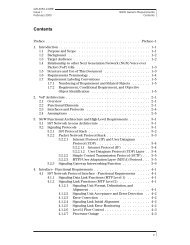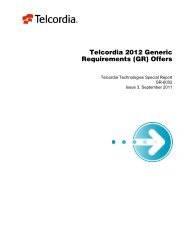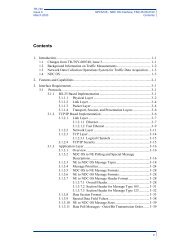(NGN) Documents - Telcordia Information SuperStore - Telcordia ...
(NGN) Documents - Telcordia Information SuperStore - Telcordia ...
(NGN) Documents - Telcordia Information SuperStore - Telcordia ...
You also want an ePaper? Increase the reach of your titles
YUMPU automatically turns print PDFs into web optimized ePapers that Google loves.
ROADMAP-TO-<strong>NGN</strong>-1<br />
Roadmap to <strong>NGN</strong> <strong>Documents</strong> Issue 2, August 2008<br />
Overview of <strong>NGN</strong><br />
2–2<br />
video, and multimedia, while maintaining the high reliability, security, ubiquity, and<br />
controlled Quality of Service (QoS) offered by today’s voice infrastructure. The<br />
<strong>NGN</strong> is intended to be able to support users with a wide range of Customer<br />
Premises Equipment (CPE), from the telephony phones in the PSTN to Internet<br />
appliances including PCs and Personal Digital Assistants (PDAs), using a variety of<br />
wireline and wireless access technologies. <strong>NGN</strong> is intended to provide an<br />
infrastructure to rapidly offer new innovative applications and services and offer<br />
service providers the option of time or usage-sensitive billing.<br />
The convergence of voice and data on the same network, coupled with the flexible,<br />
open architecture of these networks, creates a platform for the development of<br />
advanced features and services. Therefore, a Next Generation Network is define as<br />
follows:<br />
A Next Generation Network is a packet-based multi-service network<br />
supporting voice service, data applications, and advanced features.<br />
An important component of <strong>NGN</strong> is Voice Over Packet (VoP). VoP transports voice<br />
calls on packet-based data networks. The <strong>NGN</strong>/VoP presents carriers with an<br />
opportunity to migrate all information transport, i.e., voice, data, fax, image, and<br />
video, onto a single medium. This would likely create significant cost reductions on<br />
transport, switching, on-site cabling and equipment, and administration and<br />
management, with the single network for both voice and data communications.<br />
2.1.1 Next Generation Network Framework Architecture<br />
Figure 2-1 illustrates the functional elements in a typical <strong>NGN</strong> framework<br />
architecture. The key functional elements shown in the figure are defined below.<br />
The architecture relies on a Core Network and an Access Network for providing the<br />
necessary connectivity and transport. The Core Network is the packet transport<br />
network (typically based on IP-networking) that provides connectivity to the<br />
functional elements in the <strong>NGN</strong>. The Access Network represents the local loop<br />
network of the <strong>NGN</strong>. There are various ways of offering access to the <strong>NGN</strong>. The<br />
Access Network could be based on the existing copper plant of LECs or could use<br />
other technical options such as Hybrid Fiber-Coax (HFC), Digital Subscriber Loop<br />
(DSL), wireless access, etc.<br />
However, the descriptions of the Functional Elements (FEs) and the interfaces do<br />
not imply any specific physical implementation. Various suppliers have developed<br />
products with functional elements with a single node that communicate with the<br />
relevant elements in other nodes. This framework does not endorse any particular<br />
physical architecture.





